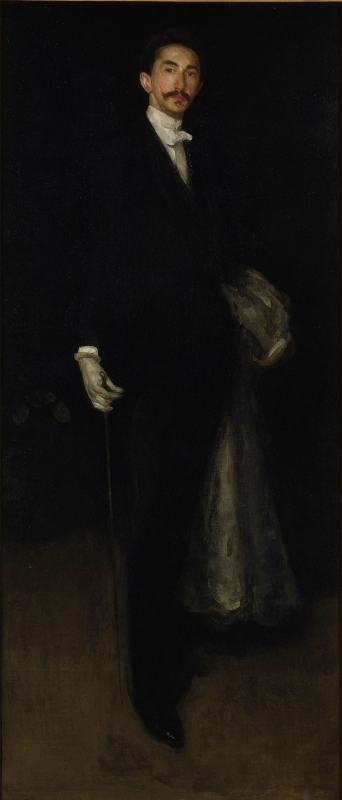Technique
It was painted on a fine weave canvas. In spite of the record number of sittings, the paint is quite thin, and there are few signs of major alterations to this portrait. His right leg was originally further left and his foot lower and to the left. Because the finely woven canvas was rubbed down between sittings, the surface, while worked over in considerable detail, is thinly painted, except for the outline of Montesquiou's shoulders, his white shirt front, and some of the modelling and colour accents on his face.
Montesquiou described Whistler at work :
" 'Tout ça bourdonne là-dessous, la toile n'est pas encore contente ..."clamait-il, en lançant les "that is it!" ... dont il accélérait son travail, aux premières séances comme frénétiques et durant lesquelles il se comporte à la facon d'un chat tigre dont on viendrait d'ouvrir la cage, au point qu'il faut, alors, enlever les meubles pour empêcher le peintre de les renverser en bondissant, lorsqu'il se recule, on dirait pour puiser une touche dans l'essence même du modèle, et la reporter sur la toile sans lui laisser le temps de s'évaporer ou s'évanouir.' 1Translated freely: 'All this buzzing about, the canvas is not happy ... he said, crying out the "that is it!" ... with which he speeded up his work, so frenetic in the first sessions, during which he behaves like a tiger cat when the cage is opened, so that it is necessary to remove the furniture to stop the painter from upsetting it when he jumps back, he seems to extract, with a touch, the very essence of the model, and to place it on the canvas without giving it time to evaporate or faint.'
Montesquiou also commented on 'cette curieuse façon de retarder, de balancer la-dite touche, de la promener dans l'air de longs instants avant de la poser à la place precise où le travail la réclamait, pour s'approcher davantage de la palpitation, de la respiration et de la vie.' 2
On 24 January 1892 Whistler wrote to his wife, Beatrice, that on his first afternoon in Paris, on Wednesday, he had a sitting from Montesquiou and did 'a great deal of good to the head', on that on Thursday he did some 'tinkering on the hand' without success:
'whereupon I made up my mind that I would not touch the background and figure until afterwards - for I was determined to go through with the whole picture in one perfect final coating - for which I had been enabled to prepare the canvass with one last scraping, and pommice stoning and washing and the terrible bag of tricks that we know only too well!' 3
Conservation History
Frame
Flat Whistler frame, signed 'F H Grau - London, 1892' [14 cm], 92 1/4 x 46 1/4 x 2 1/8". The maker was Frederick Henry Grau (1859-1892). 4
Notes:
1: Montesquiou 1923 [more] , vol. 2, pp. 257, 259-60.
2: Ibid. Roughly translates as: 'this curious way of hesitating, balancing the touch, of waving it in the air for long moments before placing it in the precise place where the work required it, to get closer to the palpitation, to the breath and life. '
4: Dr S. L. Parkerson Day, Report on frames, 2017; see also Parkerson 2007 [more] .
Last updated: 7th June 2021 by Margaret








